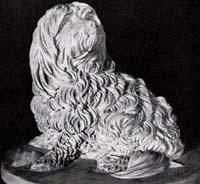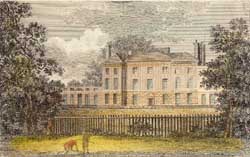Anne Seymour Damer
Sculptor
1748 - 1828

Born the only daughter of Henry Seymour Conway (later Field-Marshall) and Lady Caroline Campbell daughter of the 4th Duke of Argyll, Anne Conway spent much of her childhood at Park Place, Remenham near Henley-on-Thames. Her parents being abroad for much of the time, her cousin Horace Walpole assumed some responsibility for her care as guardian.
Although attracted to the stage early on, she embarked on a career as a sculptor, encouraged by David Hume, her father's under-secretary during 1767, and with some instruction from the sculptors Giuseppe Cerracchi and John Bacon.
She married, on 14 June 1767, the Hon John Damer, eldest son of Lord Milton. He, in the expectation of inheriting an income of £30,000 a year managed to spend the money in advance, much going on gambling and clothes: he was reputed to pester his wife by appearing in three different new outfits each day. The marriage foundered after seven years and, having squandered his patrimony he terminated his life with a pistol in the Bedford Arms, Covent Garden on 15 August 1776, leaving his widow childless and the proprietor of a wardrobe which fetched no more than £15,000 at auction.

After the death of her husband she resumed her career in sculpture, encouraged now by Walpole who, in 1780, wrote of her:
“Mrs Damer, daughter of General Conway, has chosen a walk more difficult and far more uncommon than painting. The annals of statuary record few artists of the fair sex, and not one that I recollect of any celebrity. Mrs Damer's busts from the life are not inferior to the antique; and theirs, we are sure, were not more like. Her shock-dog, large as life, and only not alive, has a looseness and softness in the curls that seemed impossible to terra cotta; it rivals the marble one of Bernini in the royal collection. As the ancients have left us but five animals of equal merit with their human figures, namely, the Barberini goat - the Mattei eagle - the eagle at Strawberry Hill- and Mr Jennings's, now Mr Duncombe's dog - the talent of Mrs Damer must appear in the most distinguished light.”

It is likely that both affection and family loyalty combined to inflate Walpole's assessment of her abilities. Without his influential promotion of her talents she would probably not have achieved the reputation she enjoyed in her lifetime. The favourable comparisons with Bernini and others give some pause for thought: is Shock actually to be compared with his neighbour Mr Duncombe's (late Jennings') dog?
Alan Cunningham wrote of her work, in 1830, that “Her earliest works are smoothest - her latter productions exhibit most character; but neither are (sic) entitled to be named with the productions of first rate artists”.

When Walpole died, in 1797, he bequeathed a life tenancy of Strawberry Hill with an annual endowment of £2,000 to his niece, making her the executrix of his will. She moved in, enjoying the company and friendship of Mary Berry next door at Little Strawberry Hill. She continued with her other love: theatre, staging and appearing in plays in the house, including one by Mary Berry. However, the 47 acre estate was more than she could manage and in 1810 she passed the property to the Countess Waldegrave and returned to London.

In 1816 her cousin Mary Georgiana Seymour (1798-1848) bought Richmond House on Twickenham's riverside, at the age of 18. She married in 1825, the Hon George Lionel Damer (1788-1856). He changed his name in 1829 to Dawson-Damer. He was the third son of the 1st Earl of Portarlington and their son, Lionel Seymour William somehow became the 4th Earl. Tradition holds that Mary rebuilt the house in 1816; perhaps an unlikely project for an unmarried 18 year old girl: a later date of 1829, usually given for an extension to the house seems more plausible, although the Dawson - Damers actually vacated the property this year.

York House nearby had been on the market and, in 1818, Anne Damer bought it with its 10 acres and a theatre built by the previous owner Count Stahremburg. There was probably a resumption of amateur theatricals: she had performed here during his tenure.
Anne died on 28 May 1828 and was taken to be buried at Sundridge in Kent next to her mother. The tools of her sculpture were placed beside her in her coffin together with the bones of a favourite dog that were preserved in a box in her bedroom.
further reading:
R. Gunnis, Dictionary of British sculptors, 1660-1851 (1953); new edn (1968)
Oxford Dictionary of National Biography
T H R Cashmore, York House, Twickenham, Borough of Twickenham Local History Society Occasional Paper No4, 1990
Percy Noble, A Woman of Art and Fashion, Kegan Paul, 1908




